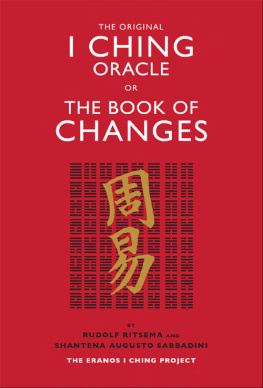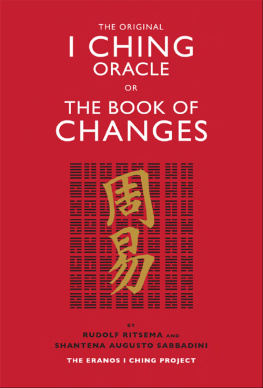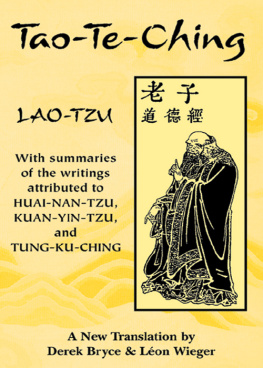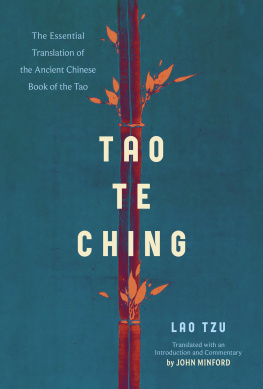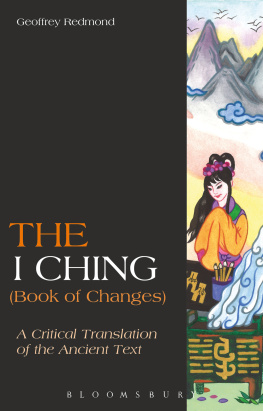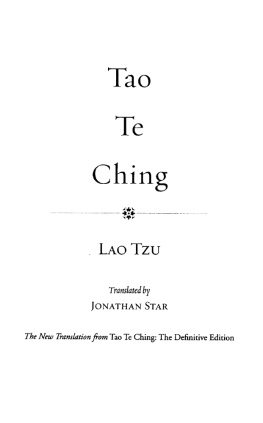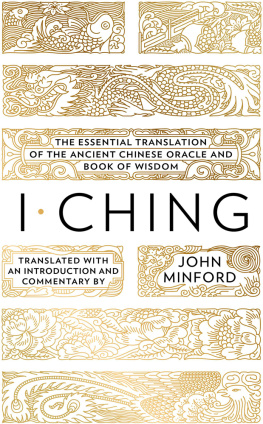Rudolf Ritsema was a devoted student of the I Ching since his first encounter with it in 1944. He was director of the prestigious Eranos Foundation for 30 years and after his retirement he published English, Italian and German translations of the I Ching. He passed away in 2006. The present definitive version of the Eranos I Ching is the distillation of his lifelong involvement with the book.
Shantena Augusto Sabbadini worked as a theoretical physicist at the University of Milan and at the University of California, where he contributed to the first identification of a black hole. Later he became interested in religion, philosophy and psychology, and in 1991 he joined the Eranos circle and became involved in the Eranos conferences as organizer and lecturer.
THE ORIGINAL
I CHING
ORACLE
OR
THE BOOK OF
CHANGES
BY
RUDOLF RITSEMA AND
SHANTENA AUGUSTO SABBADINI
THE ERANOS I CHING PROJECT
Contents
LIST OF HEXAGRAMS
THE 64 HEXAGRAMS
ZHOUYI
This book is the result of the lifelong study of the Yijing by my coauthor, the late Rudolf Ritsema, as well as the meeting and merging of our sensibilities. While the text is essentially the same as in the original 2005 edition, I felt it was appropriate to endow it with a new Introduction, both to streamline the access to the practice of the oracle and to give adequate space to Rudolfs involvement with the Yijing and with the creation of the Eranos Round Table Sessions. It is a story well worth telling that Rudolfs self-effacing style kept from being included in the previous Introduction. A special thank-you goes to my wife, Cruz Maas Pealver, for substantially contributing to the Introduction of this new edition of The Original I Ching Oracle.
Part One
Introduction
1 | The Book of Yi
THE NAME OF THE BOOK
The title of this book, Yijing, as it is written in contemporary pinyin romanization, can be translated as Book of Changes or Classic of Changes. An older form of the title is Zhouyi, Changes of the Zhou, from the name of the Zhou dynasty (1122256 BCE), under which it came into being. Jing simply means classic: its canonization as a classic took place under the Han dynasty (206 BCE 220 CE), in the framework of the great unification of Chinese culture undertaken by the empire. Since then, the Yijing has been regarded as the Classic of Classics: for 2,000 years it has been to the Chinese the ultimate map of heaven and earth.
The essential word in the books name is yi, which means, amongst other things, change. Change, as we all know, is the only permanence: existence is constant change, from the regular alternance of day and night, the sequence of the seasons, the growth and decay of all living forms. But the yi the title of the book points to encompasses also another type of change, the unpredictable change that sometimes irrupts into our life, the painful confrontation with our human limitations, stressful situations in which the usual bearings no longer suffice for orientation. The Book of Yi comes to our rescue in such situations. It was born in the first millennium BCE as a divination manual, i.e. as a practical tool to help people ride the waves of change and harness their energy: a tool to deal with yi, with critical times of change. In many ancient cultures these times were seen as intrusions of the divine, of gods and spirits, into human life, and a proper interrogation of these higher powers, engaging them in a dialogue, was considered essential in order to overcome the crisis. The Yijing was born and kept being used throughout its long history as one such method of divination, as an oracle.
Divination is mostly associated in peoples minds with predicting the future. That is not the approach to divination we propose in this book. We do not view the Yi as a tool to predict the future, because we believe the future is unpredictableand depends, among many other factors, on the course of action we choose. We suggest to use the Yi as a mirror of the present, as a tool for introspection, a tool to assess the appropriateness of a specific course of action in a given situation, a tool to open a dialogue with our own deeper wisdom and align our actions with the dao.
Such dialogue with our inner wisdom is especially useful at times of crisis. The Chinese term for crisis consists of two characters, wei and ji. Wei means danger, and ji means, among other things, moment and chance. So a crisis is a dangerous moment, but also a chance, an opportunity. It is an opportunity for growth, first of all: such times can bring profound transformationbut can be painful, disconcerting and full of anxiety.
Modern chaos theory pays particular attention to these murky transitions, by which forms transmute into each other. In fact, life itself arises at the boundary between order and chaos: it requires both, it is a daughter of both. On the side of perfect order there is no movement: there is only inertia, symmetry, thermo -dynamic equilibrium. Nothing very interesting can happen there: everything is too predictable. But the side of total disorder is not very interesting either: forms appear and disappear too quickly, there is a total lack of symmetry, everything is too unpredictable. It is on the edge between order and chaos that the subtle dance of life takes place: here the real complexity arises, here forms bend and loop and transmute and evolve.
The Yijing is the ancient Chinese map of this dance of order and chaos. It is based on two principles, yin and yang, that are closely related to the ideas of structure and action, form and energy. Pure yin is structure, with no movement; pure yang is chaotic creation and destruction, no form. But the interplay of yin and yang gives birth to the myriad beings, the endless variety of life and the marvelous complexity of the world. In the Yijing this dance is encoded in 64 hexagrams, figures composed of six opened (yin) or whole (yang) lines, diagrams of different combinations of the two basic principles.
YIN AND YANG
Yin and yang are the fundamental polarity of this system. These two basic categories of Chinese thought cannot be adequately translated in Western terms. In order to understand them correctly, we must keep in mind that they represent aspects of processes and not qualities of things. Nothing is intrinsically yin or yang.
As a first approximation, we can say that yang refers to action, and yin to concrete form in space. For example, when we look at writing as the action of tracing signs on paper, it can be described as yang; while the signs themselves, the written document produced by this action, can be described as yin.
Yang is sometimes characterized as creative, while yin is characterized as receptive. But that is not quite correct, because no creation is possible through pure action without ever reaching a consolidated form (and likewise no creation is possible through form without action). All creation is the result of the inter-penetration of these two complementary aspects and of their dynamic interplay.
Next page
